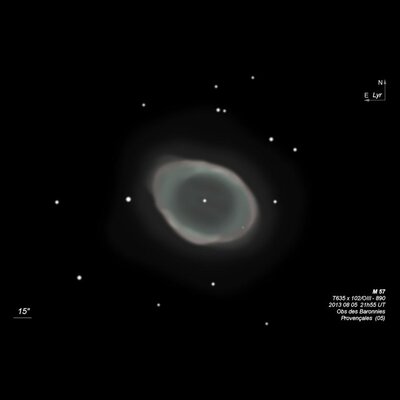Ring Nebula
Ring Nebula

15x50mm IS binoculars (6/19/09): fairly faint but clearly non-stellar, appearing as a very small but definite disc.
Antoine Darquier discovered M57 = NGC 6720 = h2023 using a 2.5-inch refractor in early 1779. He wrote, "nebula between Gamma and Beta of Lyra; it is pretty dull, but perfectly outlined; it is as large as Jupiter and resembles a fading planet." This description perhaps inspired the name "planetary nebula". It has been assumed the Darquier's discovery preceded Messier's independent discovery, but Don Olson and Giovanni Maria Caglier reported in the June 2017 issue of Sky & Tel, that Messier definitely observed the Ring Nebula on 31 Jan 1779 while searching in the region of Bode's comet. Darquier wasn't even aware of Bode's comet until at least 9 Feb, so Messier deserves discovery credit. In any case, M57 was the second PN discovered, after M27 in 1764.
In 1785 William Herschel logged, "A perforated Nebula, or Ring of Stars. Among the curiosities of the heavens should be placed a nebula, that has a regular, concentric, dark spot in the middle, and is probably a Ring of stars. It is of an oval shape, the shorter axis being to the longer as about 83 to 100; so that, if the stars form a circle, its inclination to a line drawn from the sun to the center of this nebula must be about 56 degrees. The light is of the resolvable kind [i.e., mottled], and in the northern side three very faint stars may be seen, as also one or two in the southern part. The vertices of the longer axis seem less bright and not so well defined as the rest. There are several small stars very near, but none seems to belong to it."
The discovery of the challenging central star (V = 15.7 according to http://arXiv.org/abs/astro-ph/0611543) is generally attributed to Friedrich von Hahn in 1795 using a 12" f/20 reflector (mirror from William Herschel). Though he subsequently reported the "small star is no longer visible", I find his original observation unlikely as his telescope was probably equivalent to a modern 8" or 9" reflector. William and John Herschel never reported seeing the central star, nor Lord Rosse in his 36-inch. Apparently it was missed by Trouvelot with the Harvard 18" and Holdenwiththe Washington 26" refractor. Rosse found the central star "pretty bright" with the 72-inch (first seen in 1848) and William Lassell sketched the central star with his 48" in 1860 (unpublished). Father Secchi claimed an interior star was seen with the 9.5" refractor in Rome around 1865. A second interior star was observed through the Lick 36-inch refractorand one at the end of the major axis.
The 1936 Carnegie Institute Yearbook mentions that a photograph made with the Mt. Wilson 100-inch by Duncan revealed a "faint, hitherto unrecorded envelope, roughly circular in outline and about twice the diameter of the well-known ring." Soon afterwards, a larger outer envelope was found in NGC 6826.
100/150mm - 6" (7/78): first view in a dark sky (Bryce Canyon), high surface brightness, ring-shape obvious, easily takes high power, slightly elongated. Visible in 8x50 finder as a faint "star".
300/350mm - 13" very bright, moderately large, slightly elongated WSW-ENE, high surface brightness, best example of annularity although interior not dark. Slightly fainter at ends of major axis. Central star not seen.
400/500mm - 17.5" (6/5/99): Viewed under very steady seeing at 380x. The halo was elongated 4:3 WSW-ENE and clearly brighter along the north and south sides (minor axis). The ends of the major axis were clearly "thinner" and slightly fainter at the following end. The interior had a pale gauzy appearance. The edge of the ring has a "wooly" appearance with a strong impression of small irregular wisps or filaments hinting at the extremely faint outer halo. The central star popped in and out of view a few times. A mag 13 star is close off the east side and a very faint mag 15.7 star is a similar distance off the west end. Another mag 15.6 star is 1' due south of center. At high power a 3" pair of mag 14-15 stars ~1.3' NNW of center were just resolved with a difficult mag 16.1 star ~30" further north.
17.5" (7/1/89): extremely faint central star visible for moments at 412x just east of center. The central star was held steadily for a few seconds at best with averted vision. Forms an unusual pair with the extremely faint galaxy IC 1296 4' NW.
600/800mm - 24" (5/25/14): observed M57 at 1000x (4.5mm Delos + 2x Powermate) in excellent seeing. The Ring itself was stunning with mottling, textured surface, and brightness variations across the ring clearly visible. The central star was very faint, but visible ~75% of the time (sometimes as a quasi-stellar brightening). Often, though, it was seen as a sharp stellar point. Overall, this was certainly one of the finest views of the Ring I've experienced.
900/1200mm - 48" (10/24/11): at 488x and 610x the central star was easily visible continuously in fair seeing. Using 287x and an NPB filter, a much fainter large outer halo was easily visible surrounding the main bright ring (86"x63"). It appeared much more circular than the ring and ~2.5' diameter (roughly doubling the size), so appeared to extended further out in the direction of the ring's minor axis. This outer shell was surprisingly evident and even displayed a slightly ragged or irregular edge.
Notes by Steve Gottlieb